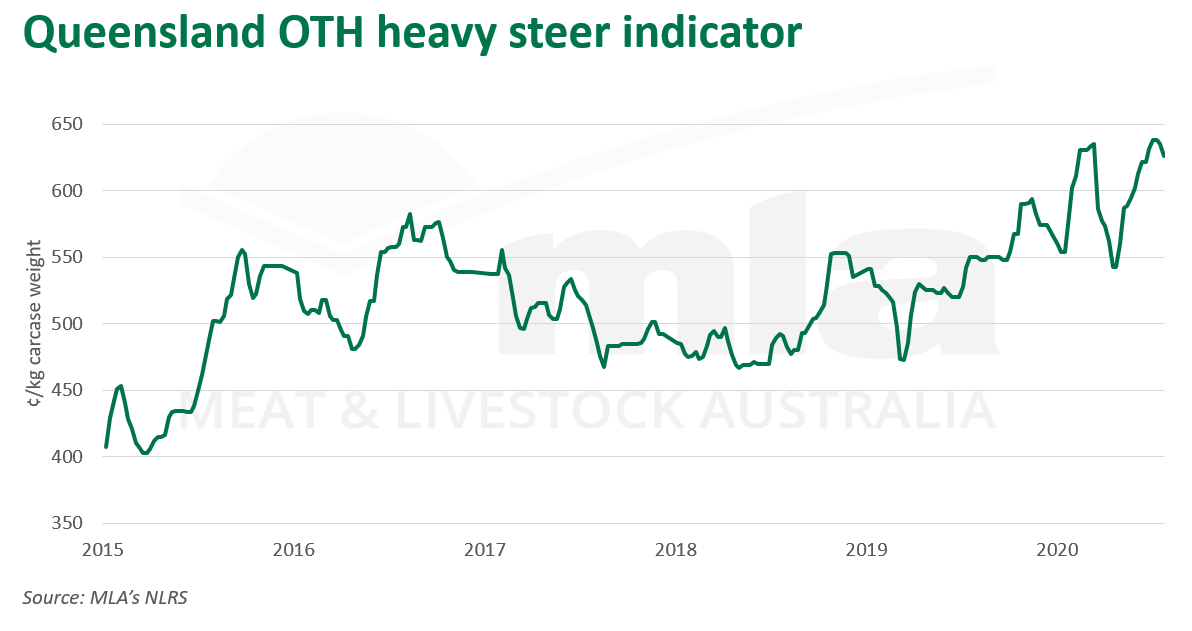Key points:
- Young cattle maintain a premium to finished cattle
- Northern markets are driving this premium, with restockers active in the market
- Finished cattle prices edge lower
Grids adjust
Most northern processor grids edged lower this week, the result of a myriad of challenges facing processors in overseas markets. Reported cases of COVID-19 in many overseas markets have risen in recent weeks, with foodservice outlets in isolated cities, particularly in the US, returning to lockdown. The economic uncertainty has also rippled through to the Australian dollar, now reported at US71¢, applying further pressure to exporters.
In Queensland, trade steers were back 4¢ on the week prior to 626¢/kg carcase weight (cwt), with the heavy steer and medium cow over-the-hook indicators easing 3¢, to 635¢/kg and 537¢/kg, respectively. At the saleyard, finished cattle found modest support this week, with competition for limited lines of finished cattle largely keeping prices stable on the week prior. Across all states, finished cattle prices remain above year-ago levels, with domestic conditions still providing overriding support to prices.

Unlike the young cattle market, which has seen a northern premium over southern markets, Victoria continues to uphold a premium for finished cattle compared to its northern counterparts. Heavy steers out of Victoria were trading at 699¢/kg cwt on Tuesday 21 July, a 46¢ premium to New South Wales and a 109¢ premium to Queensland. Despite heavy steer prices showing a steady decline since the start of the month, the national indicator has found support from recent rainfall across pockets of the eastern states and has remained above 600¢/kg since February.
Store market
For the year so far, young cattle have maintained a premium to finished cattle, albeit both continue to track well above year-ago levels. Eastern Young Cattle Indicator (EYCI) eligible cattle have traded at an average premium of 74¢ to heavy steers since January, with the spread between the two diverging since the start of the month to 98¢/kg carcase weight (cwt) on Tuesday 21 July. Unsurprisingly, improved conditions have resulted in demand for store cattle lifting as competition between restocker and feeder buyers intensifies.
On Tuesday 21 July, the EYCI averaged 750¢/kg cwt, up 220¢/kg on the year prior, while the national heavy steer indicator was reported 96¢/kg higher year-on-year to 652¢/kg cwt.
Since the start of 2020, 88% of EYCI eligible cattle have been sold through New South Wales and Queensland saleyards. Large parts of the eastern states experienced widespread rainfall in the first quarter, encouraging northern restockers back into the market. In New South Wales and Queensland, restockers have accounted for 37% and 41% of EYCI eligible cattle respectively for the year to date, with Victoria restockers accounting for 12%. Unsurprisingly, the spread between northern and southern young cattle prices has widened, with Queensland averaging 701¢/kg cwt and New South Wales averaging 714¢/kg cwt, up 70¢/kg and 83¢/kg respectively on Victoria.
© Meat & Livestock Australia Limited, 2020
To build your own custom report with MLA’s market information tool click .
To view the specification of the indicators reported by MLA’s ³Ô¹ÏÍøÕ¾ Livestock Reporting Service click .






